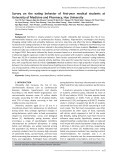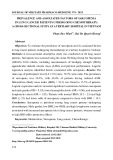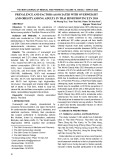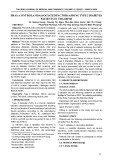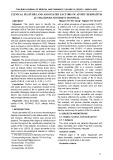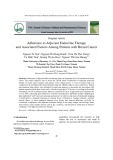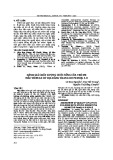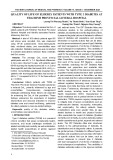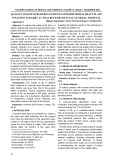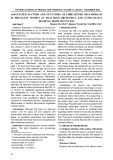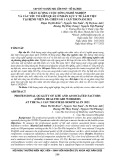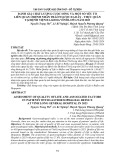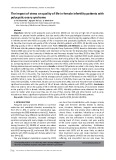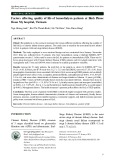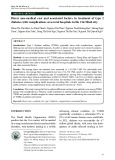
THAI BINH JOURNAL OF MEDICAL AND PHARMACY, VOLUME 14, ISSUE 5 - DECEMBER 2024
4
1. Thai Binh Provincial General Hospital
2 Thai Binh University of Medicine and Pharmacy
*Corresponding author: Nguyen Duy Cuong
Email: cuongnd@tbump.edu.vn,
Received date: 31/10/2024
Revised date: 11/12/2024
Accepted date: 13/12/2024
QUALITY OF LIFE OF ELDERLY PATIENTS WITH TYPE 2 DIABETES AT
THAI BINH PROVINCIAL GENERAL HOSPITAL
Luong Thi Phuong Thanh1, Vu Thanh Binh2, Tran Xuan Thuy2,
Hoang Van Thuan2, Nguyen Duy Cuong2*,
ABSTRACT
Objective: This study aimed to assess the QoL of
elderly patients with T2DM at Thai Binh Provincial
General Hospital and identify associated factors
influencing their QoL.
Method: A total of 303 elderly patients aged 60
and above were recruited. QoL was measured
using SF-36 questionnaire. Socio-demographic
data, nutritional status, and comorbidities were
also collected. Statistical analyses were conducted
to evaluate associations between these variables
and QoL scores.
Results: The average QoL score among
participants was 48.7 ± 7.4. Significant differences
in QoL were observed by age, with patients aged
60-69 reporting the highest scores (50.7 ± 7.2) and
those aged 80 and older the lowest (46.0 ± 6.6), p =
0.0002. Comorbidities significantly impacted QoL;
patients with neurological disorders had scores of
46.9 ± 7.1 compared to 50.0 ± 7.3 for those without
(p = 0.0002).
Conclusion: Elderly patients with T2DM at
Thai Binh Provincial General Hospital experience
a reduced QoL, primarily influenced by age and
comorbidities. Comprehensive management
strategies addressing these factors are essential
for enhancing the QoL of this population. These
findings underscore the importance of targeted
interventions and resource allocation to improve
diabetes care and overall well-being, particularly
for elderly patients in resource-limited settings.
Keywords: quality of life; diabetes; elderly;
comorbidities; associated factors
I. INTRODUCTION
Type 2 diabetes mellitus (T2DM) is a prevalent
chronic condition that poses considerable health,
economic, and social challenges worldwide [1]
related morbidity and mortality, as well as diabetes-
related health expenditures at global, regional
and national levels. The IDF Diabetes Atlas also
introduces readers to the pathophysiology of
diabetes, its classification and its diagnostic criteria.
It presents the global picture of diabetes for different
types of diabetes and populations and provides
information on specific actions that can be taken,
such as proven measures to prevent type 2 diabetes
and best management of all forms of diabetes to
avoid subsequent complications. The credibility of
diabetes estimates relies on the rigorous methods
used for the selection and analysis of high-quality
data sources. For every edition, the IDF Diabetes
Atlas Committee – composed of thematic experts
from each of the seven IDF Regions – reviews
the methods underlying the IDF Diabetes Atlas
estimates and projections and available data
sources. The majority of the data sources used are
population-based studies that have been published
in peer-reviewed journals. In this edition, we have
also included data from national diabetes registries.
With the establishment of electronic records and
national registries becoming more common, we
anticipate more data like these will be featured in
the future. Furthermore, information from national
health surveys, including some of the World
Health Organization (WHO. Characterized by
insulin resistance and a gradual decline in insulin
production, T2DM requires ongoing management
to mitigate risks of severe complications such as
cardiovascular disease, neuropathy, retinopathy,
and nephropathy. For elderly patients, these
complications pose even greater risks, as age-
related declines in health and physical function
often exacerbate the impact of diabetes [1]related
morbidity and mortality, as well as diabetes-related
health expenditures at global, regional and national
levels. The IDF Diabetes Atlas also introduces
readers to the pathophysiology of diabetes, its
classification and its diagnostic criteria. It presents
the global picture of diabetes for different types of
diabetes and populations and provides information
on specific actions that can be taken, such as
proven measures to prevent type 2 diabetes
and best management of all forms of diabetes to
avoid subsequent complications. The credibility of
diabetes estimates relies on the rigorous methods






